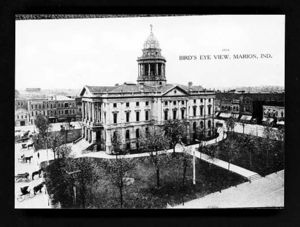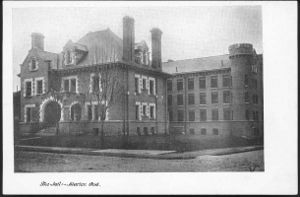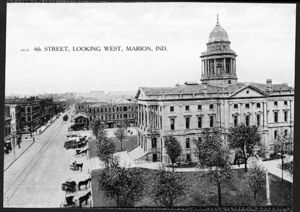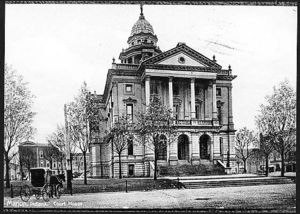Marion Lynching

The Shooting
Tension was in the air in 1930 Marion. Prohibition had led to political corruption. The first effects of economic depression were being felt on area farms and in factories. The Ku Klux Klan, an active force in the community in the first half of the 1920's, had faded but its legacy of white supremacy remained present. Crime was on the increase. In 1929 three Marion residents were murdered in an incident known as the Labor Temple Bombing. It is in this atmosphere that the lives of five young people would change forever as would the history of the city and county. Allison Richardson and Christofer Morton provide further context about Marion In the 1920s.
What can be gathered from reports is that three black youths, Thomas Shipp, Abe Smith, and James_Cameron, held up Claude Deeter and Mary Ball as they were parked at the local lover's lane. During the hold up, one of the youth shot Deeter multiple times, leaving him on the side of the river. Newspapers later reported that Mary Ball was raped and left on the side of the road (Ball later revoked these claims in the Court of Law). She was rescued by a passing motorist. Claude crawled to the road and was picked up and taken to Marion General Hospital.
Claude Deeter was rushed to Marion General Hospital in critical condition. After observation, the doctors confirmed that there was little chance of survival. Claude's family was present, and his mom urged him to forgive his attackers. After finally deciding to forgive, Claude Deeter died Thursday, August 7, 1930 at 1:30pm. His bloody shirt was hung in the window by the sheriff.
The Lynching
News of the shooting and alleged rape spread quickly through out the town. This greatly angered the people, who were even more enraged after seeing the bloody shirt of Claude Deeter hanging from the window of the courthouse. A small mob began to gather at the jail, growing rapidly in number.
The Deaths of Tom Shipp and Abram Smith
When the mob broke into the jail, Shipp made a futile attempt to hide within his cell. He was dragged form his cell, members of the mob repeatedly beating him with shoes and other objects. He was then lynched from the window of the jail. It has been reported by some observers that Shipp was dead before being hung. Shipp's body was repeated beaten even after being hung. It was later taken down and hung next to that of Abe Smith on the maple tree by the courthouse.
After the death of Tom Shipp, the mob made their way up to the third floor where Abe Smith was located. When he bit one man on the arm, another struck him on the head with a crowbar (Madison, p.9). Smith was then dragged for a block to the courthouse, repeatedly beaten by young men. When they arrived, many women from the crowd ran up, yelling insults and stomping on Smith's head. He was then lynched on a maple tree. Due to the excessive beating, Smith's clothes had torn away from his body. A member of the crowd wrapped a feed sack around his torso and a towel around his legs in order to hide his nakedness.
The Survival of James Cameron
James Cameron was dragged to the now deemed "lynching tree" by the mob shortly after the move of Tom Shipp's body. He was beaten and placed between the two bodies of his friends. Right before the rope was thrown over his neck, a voice cried out over the noise of the mob, declaring Cameron innocent of the crimes accused. The indentity of the owner of the voice remains a mystery (Cameron claimed it was an angel sent from God.) For some unknown reason this seemed to calm the mob, and James Cameron was escorted back to the jail to await trial.
The Aftermath
The Trials
The Marion Lynching Trials that followed remain a heated topic of debate. When Tom Shipp and Abe Smith were lynched, the African American community and its supporters demanded justice.
The entire judicial system was manipulated by members of the mob and government officials who wanted to get reelected next term and could not afford to lose the votes of white citizens in Grant County. Flossie Bailey worked hard with the NAACP in order to obtain a fair trial for both James Cameron and the alleged members of the mob.
Repercussions
Numerous versions of the story circulated in town, and they shaped life in Marion for decades afterward. Oral historian Barbara Stevenson-Spurgon shares these stories and reflects on their influence in a 2011 interview. Marion’s lynching was only one of thousands that took place across the United States. Meredith Kuczora places the event in this broader context.In the 1980s, James Cameron became a civil rights activist for the memory of lynching. He founded the America’s Black Holocaust museum in Milwaukee in 1988. In the 1990s and 2000s, a number of reconciliation events were held, including a 1993 pardon from governor Evan Bayh and a 2003 "Day of Reconciliation" organized by a group of local pastors. A stage dramatization of the events, The Gospel According to James, opened at the Indianapolis Repertory Theater in 2011. However, no physical memorial has been erected. Evan Munn takes up this question, exploring the consequences of memorialization in other cities.
For people who would like to learn more about the Marion lynching, numerous resources are available, including books, documentaries, and websites. Some of the best are reviewed by Jessey Nettey.
Lynching Map
The map below includes places pertaining to the Marion lynching. <googlemap lat="40.546939" lon="-85.658512" zoom="13" width="600" height="400" controls="large">
40.525234, -85.624845,.
Grant County Jail: This is where the accused Tom Shipp, James Cameron, and Abram Smith waited all day as a mob of angry townspeople began to accumulate outside on August 7, 1930.
40.550763, -85.69028, The Residence of Mary Ball and her family. ("Bullet Wounds Prove Fatal to Holdup Victim") 40.528285, -85.663505, The Residence of Abram Smith: The location according to the City Directory 1929. 40.557169, -85.658398, Marion Malleable Iron Works: The Marion Iron Works employed Tom Shipp up until his alleged rape of Mary Ball and the murder of Clyde Deeter. 40.552263, -85.693274, Northern Indiana Power Track Station Shoe Parlor: This was the place at which James Cameron was employed up until his alleged involvement in the rape of Mary Ball and the murder of Claude Deeter.
40.558034, -85.658576,</googlemap> Map created by Joe Turner
Work Cited
- Bullet Wounds Prove Fatal to Holdup Victim. Marion Chronicle August 7. 1930. Page 1 Column 7. Print.
- City Directory 1929 Vol. 1
- Madison, James H. A Lynching in the Heartland . New York, NY: Palgrave, 2001. Print.
Credits
This exhibit was created by Rachael Bingham, Dallas Elliot, Kiley Furnish, Brandon Hauser, Rett Huntington, Haley Jordan, Meredith Kuczora, Charles Kuntz, Jessica Martin, Sulma Martinez, Matt Mast, Mary Moreno, Christofer Morton, Evan Munn, Jessey Nettey, Allison Richardson, Devin Spurgon, Megan Swan, and Joe Turner. The project was created in Mr. Munn’s ACP US History class at Marion High School during spring 2011, also with help from Rob Lucas.
We wish to thank James Madison, Cynthia Carr, Ken Folks, Stephen Edwards, Larry Batchelor, Bobbie Owensby, Rhonda Stouffer, Betty Reynolds, the rest of the staff of the Indiana Room at the Marion Public Library, and the staff of the Indiana Repertory Theatre.





